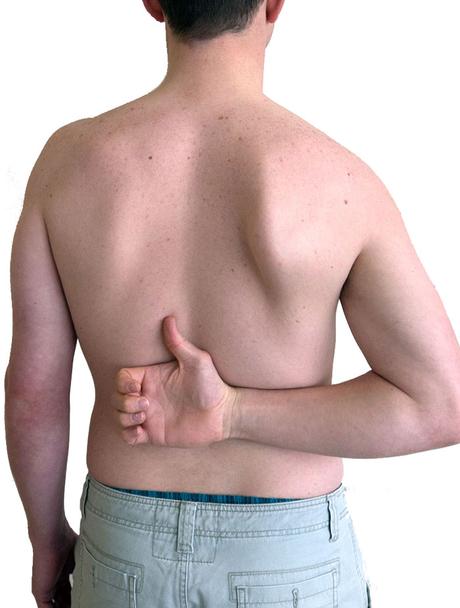Dysfunction of the scapula or scapular dyskinesia is a condition in which the scapula does not perform movements by other adjacent members. This disorder is caused by injury, weakening, and imbalance of the shoulder muscles in the scapula. Voluntary movement disorder (Dyskinesia) can cause problems in the shoulder or any part of the body, including tics, mild tremors, and uncontrollable movements.
The shoulder joint consists of a ball joint in the head of the humerus and a socket joint in the scapula (shoulder blade). The joint should move so that the ball and socket are aligned. Failure to maintain normal shoulder alignment can lead to scapular dysfunction. The scapula or shoulder blade is a large triangular bone in the upper back. This bone is surrounded and supported by muscles to help the person move the arm.

Causes of Scapular Dyskinesia
The causes of scapular bone dysfunction are:
- shoulder weakness
- Shoulder imbalance
- Tightness or separation of the muscles controlling the scapula
- Damage to the nerves supplying and supporting the scapular muscles and shoulder joint
Scapular dysfunction or scapular dyskinesia results in a deviation or change in:
- Causes problems in the normal state of shoulder rest, which includes three things:
- Winged scapula: the protrusion of the inner border of the scapula and the lower angle relative to the chest
- Shoulder tilt and stretch
- Scapular disorders: scapular deformity and protrusion of the lower medial border
- cause problems in the normal movement of the scapula, especially when moving the arm, which is a disturbance in the coordination of the scapula with other organs. In this type of disorder, the patient’s scapula rises too early, or the patient experiences insufficient upward and downward rotation of the scapula when raising the shoulder when raising the arm. (Scapular downward rotation syndrome)
The medical term for these disorders is scapular dyskinesia. Scapular dyskinesia may also make it difficult to move the arm during activities such as aerobic activities, as well as cause weakness in the shoulder.

Symptoms of Scapular Dyskinesia
The most common symptoms of scapular dyskinesia include the following:
- Pain or tenderness around the scapula, especially on the top and inside of the scapula and shoulder
- Weakness in the previously injured arm.
- When trying to use the arm with great intensity, a feeling of fatigue and numbness may accompany you.
- Fatigue from repetitive activities, especially overhead movements
- Limited range of motion, especially the inability to raise the arm above shoulder height
- Accompanying the movement of the shoulder with a sound in the shoulder
- Swelling, swelling, and abnormal appearance of the shoulder
- A sloping or hanging position in the shoulder has had a previous injury.
Treatment of Scapular Bone Dysfunction
In some cases, symptoms of scapular dysfunction may be treated with simple home remedies that include:
Restoring Body Posture
Try to stand and sit appropriately while performing daily activities. Pull your shoulder blades back and bend your elbows down and back as if you want to put your hands in your back pockets.
Maintaining Balance During Exercise
If one has a regular exercise program, one should ensure that the sessions are balanced for upper body strength. Also, the exercises should include stretching exercises for the front shoulder muscles and shoulder joint rotation.
Heat Therapy
Using a hot tub or heating pad can help reduce shoulder muscles.
If symptoms persist, it is essential to see a doctor. A doctor can help determine the exact cause of dyskinesia and offer treatment options. The doctor will discuss the patient’s medical history and general health and ask questions about the symptoms. For a better diagnosis, the doctor examines the entire shoulder and scapula, diagnoses the injury, weakness, or cramping, and gives the best prescription. Physical examination usually includes the following:
Visual Observation
The doctor looks at the affected shoulder from behind and compares it with the unaffected side. To see if scapular dyskinesia or scapular dysfunction is present, the patient may be asked to raise and lower the arms 3 to 5 times. Sometimes, by carrying light weights in their hands, he gets information about scapular dysfunction symptoms, which are usually any muscle weakness.
Examinations with Muscle Palpation
The doctor performs tests such as the strength of the shoulder and scapula muscles to determine whether muscle weakness leads to abnormal movement of the scapula or not.
- Corrective maneuvers include specific tests that help the doctor learn more about the patient’s condition. These tests include the following:
Scapular Assist Test (SAT)
In this test, the doctor applies gentle pressure to the patient’s shoulder to help the patient lift the arm. If the symptoms resolve and the range of motion increases, this is a sign that the muscles are not strong enough to lift the arm.
Shoulder Retraction Test (SRT)
In this test, the doctor tests the strength of the patient’s arm by squeezing the patient’s outstretched arm. Then the doctor manually puts the scapula into the abduction position and tests the patient’s strength again. In patients with scapular dyskinesia or scapular movement disorder, muscle strength is improved by retracting the shoulder blade.
Imaging studies are not always necessary to diagnose scapular dyskinesia or scapular dyskinesia. If the doctor suspects a scapular bone abnormality, he may order an imaging test such as an X-ray, computed tomography (CT), or magnetic resonance imaging (MRI) scan.
In most cases, the doctor can detect shoulder changes by observing and examining the patient’s back. In these cases, the inner part of the shoulder blade on the injured side is more prominent than the opposite side. As the patient’s arm begins to bulge, this bulge will often appear exaggerated.
It can be said with certainty that in all cases, the symptoms of scapular movement disorder will improve with non-surgical treatment. One possible non-surgical treatment for scapular motion disorder is nonsteroidal anti-inflammatory drugs (such as ibuprofen and naproxen), which can help relieve pain and swelling.
Another non-surgical treatment for scapular dyskinesia can be physical therapy, which is designed to strengthen the shoulder muscles, restore the proper position of the scapula, and make appropriate movements for other upper body members. Most patients with dyskinesia due to muscle weakness or tightness do not need surgery. However, if an injury causes the patient’s dyskinesia in the shoulder joint, the doctor may perform a procedure to repair or reconstruct the damaged tissues. After repairing and reconstructing the damaged tissues, physical therapy and rehabilitation are performed to restore the normal movement of the scapula.

Physiotherapy of Scapular Dysfunction
A physiotherapy specialist or physiotherapist provides an exercise program for physiotherapy of shoulder dysfunction, which targets the specific causes of the patient suffering from shoulder dyskinesia. This exercise program includes physical therapy exercises that focus on strengthening and stretching the muscles around the shoulder. In addition, overall physical therapy sessions for scapular dysfunction usually focus on stabilization and strengthening of the muscles, scapular movement, and stretching the muscles that limit scapular motion.
Once the cause of the patient’s dyskinesia is resolved and normal shoulder position and motion are restored, the doctor may recommend a flexibility and aerobic strengthening program. These exercises will benefit mainly if the patient’s occupational or recreational activities include intense and repetitive shoulder and arm movements. All exercises should be done three times a week under the supervision of a physiotherapist, and if the exercises cause more pain, they should be stopped immediately.

